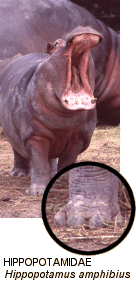 |
The Hippopotamidae is a small family containing two extant species, both
of which are restricted in their present distribution to the African continent.
Both the very large river hippopotamus (Hippopotamus amphibius, weighing
in at up to 4,500 kg) and the smaller pygmy hippopotamus (Hexaprotodon
liberiensis, weighing up to 270 kg) have heavy, barrel-shaped bodies
supported by short, stubby legs. Both species are amphibious: most terrestrial
activity (foraging) occurs at night, with the days being spent submerged
in water.
This family originated in Africa during the early Miocene, and rapidly expanded into Europe and Asia by the late Miocene. Fossils of at least three species of hippopotamus are known from Pleistocene deposits of Madagascar. Of the two modern species, the pygmy hippo is the more conservative; indeed, there is no fossil record to indicate its ancestry. The Hippopotamidae are placed within the suborder Cetancodonta along with whales and dolphins (Cetacea) as the result of molecular research. The early fossil record of this family (and suborder) is scarce, and thus the common origins of these two family groups remain obscure. The Hippopotamidae share several features with the Cetacea, although whether they are shared traits or the result of evolutionary convergence is uncertain. Besides (or because of) their (semi)aquatic existence, hippos and cetaceans both possess internal testes, virtually naked skin (the only hairs in hippos are found on the face and tail), and give birth in the water, with the infant being delivered rear-end first (the opposite of most mammals). Recent observations of hippos underwater have revealed vocalizations which sound similar to the echolocation clicks used by cetaceans. Like many semi-aquatic animals, the head and skull of hippos are distinct in form, with elevated orbits (eyes), ears, and nostrils; these features protrude above the surface of the water while the rest of the head and body remain beneath the surface. The nostrils and ears can be closed while underwater. The dental formula is I 2-3/1-3, C 1/1, P 4/4, M 3/3 x 2 = 38-44. Both the incisors and canines are tusk-like and grow continuously, being used for intraspecific competition, not food acquisition (the lips have a tough edge which is used to rip off vegetation). The stomach of hippos is multichambered but not ruminating. The limbs are robust and have four well-developed digits, each capped with a hoof-like nail. The last phalanx of each toe touches the ground, while the rest of the foot is supported by a pad of connective tissue; the foot posture is semi-digitigrade. Hippos have a very short gestation period for their size (only 6-8 months). |
(From Price, Bininda-Emonds, and Gittleman, 2005)
| Return to Artiodactyla |
Choeropsis liberiensis |
or jump to the Hippopotamidae Species List